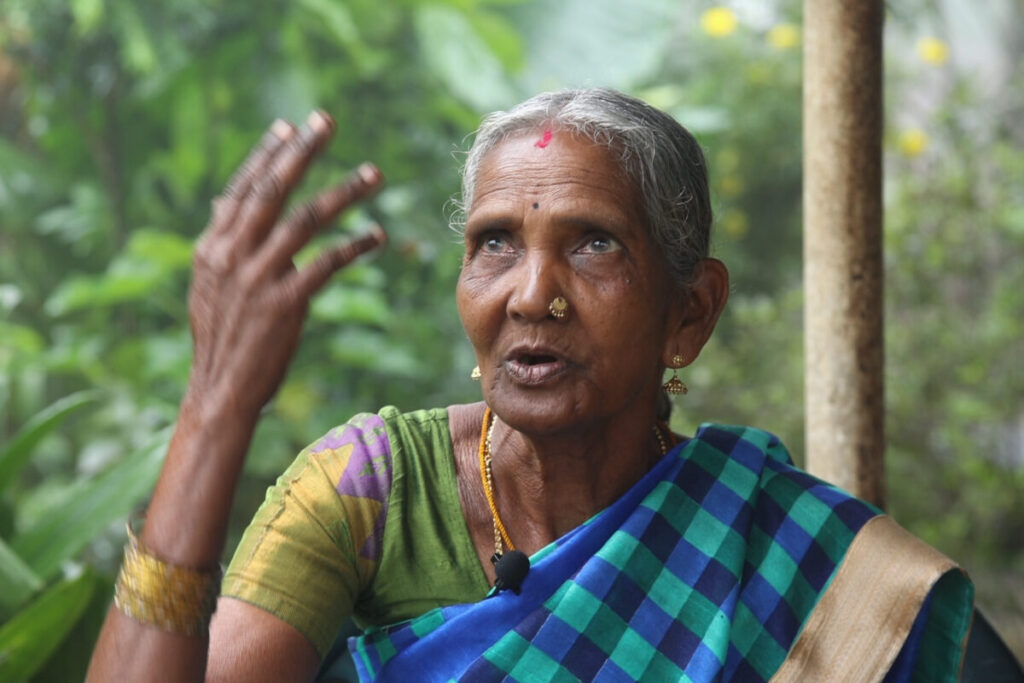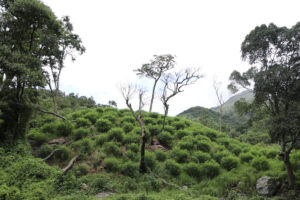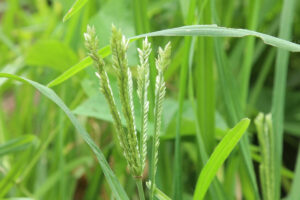Adivasis Revive Millet Cultivation To Preserve A Fading Tradition
Dec 8, 2023 | Pratirodh Bureau
Healer Rangiyamma Vaidyar prescribes a millet diet for a host of lifestyle diseases (Photo by John Bennet/Mongabay)
- Millets have been an integral part of the adivasi culture and lifestyle in the Western Ghats’ highlands of Attappadi, Kerala.
- Government support and a newfound market interest have now increased the demand and support for millet farming in the region.
- Uncertain rainfall, foraging wild animals and shortage of land make millet cultivation challenging. Experts suggest a sustainable development approach that accounts for climatic, socio-ecological and cultural aspects.
In the rain shadow region of the Western Ghats, the hillside forests flanking adivasi hamlets in Kerala’s Attappadi highlands are fostering a promising crop — millets.
The market is abuzz with the potential of this superfood that’s pounded, packed and sold in supermarkets, served as porridge, pasta and pastries in new age cafes. The Government of Kerala’s Millet Village initiative, launched in 2017, subsidises millet farming, boosts sales and makes them available in shops and schools. At a global scale too, millets are becoming popular. The UN designated this year as the International Year of the Millets to promote these hardy, rainfed, small grains worldwide.
For the adivasis of Attapadi, millets have been integral to their culture for generations.

“We would have finger millet puttu (steamed flour laced with coconuts), sometimes rice, kodo rice, sorghum puttu,” said Rangiyamma Vaidyar (77), a sprightly, silk-sari-clad woman, describing her childhood menu. She is Pudur panchayat’s popular healer. “We never had [ailments like] diabetes, ulcer, cough…”
Food scientists note that the nutritional value of millets is unmatched. As FAO points out: “Millets, as whole grains, have a higher nutritional content compared to refined cereals including wheat, rice or corn. Millets can be good sources of minerals, dietary fibre, vitamins and protein, depending on the species, variety and growing conditions. They have a lower glycaemic index than other grains so could be a good option for people with high blood sugar. Millets are also gluten-free and a cost-effective source of iron.”
Vaidyar said she often prescribes a millet diet as an antidote to an assortment of lifestyle diseases such as diabetes and hypertension. She has posted a long list of remedies on a roadside signboard, drawing people from far and near for her powders, pastes and prayers.
She recalls how her grandfather would only ever go grocery shopping for salt. “The backyard forests provided everything else — millets, greens, pulses, fruits, vegetables and game meat.”
Millet Moves From Margins To Mainstream
Millets were consumed in south India right from 2800-1500 BC, studies show. They were the staple food for centuries. Eventually, they were pushed to the highland margins, along with the adivasis. Further, state policies that favour rice and wheat as part of the Green Revolution led to a decline in area under millet cultivation.

“Even until 50 years ago, millets were the major grain grown in India,” notes a publication of the International Crops Research Institute for the Semi-Arid Tropics. “From a staple food and integral part of local food cultures, just like many other things, millets have come to be looked down upon by modern urban consumers as coarse grains…”
The agriculture department’s Millet Village project, now part of the Rebuild Kerala Initiative, along with the Integrated Tribal Development Project (ITDP)’s Namithu Vellame initiative promote millets in more than half the hamlets in Attappadi, officials said. The project aims to “rejuvenate” the old ways. “Studies in hamlets showed that people were leaving their traditional food habits and there is a need to revive these traditions,” says Thushara V., a government agriculture assistant. The initiative covers eight millets — finger, little, foxtail, proso, kodo, barnyard and pearl millets and sorghum — as well as groundnuts, vegetables and mustard.
In 2022-23, the project covered 643 hectares of farms in the first season and 543 hectares in the second, according to official figures. It came as a boon and promoted the conservation and exchange of indigenous seeds for many seasons. The offer of minimum support prices and subsidies provide the much-needed support for cash-strapped adivasi communities. There are different subsidies, such as Rs. 12,000 per hectare per season for finger millets. Processing units buy the produce from farmers and sell them to bulk buyers and others. In one year, the plant at Cheerakadavu village in Pudur panchayat sold about 7000 kg of processed grain.
“The subsidy helps us cultivate millets in the good old way,” Kuppa Mooppan, the chief of one of the Kurumba villages, said. According to him, farming can be remunerative, though challenges such as weather vagaries and wild animal attacks often prevent adivasis from investing more in farms.
Millet Revival Brings Hope Of Food And Nutritional Security
Increased household consumption and distribution of millet through schools contribute to nutritional security, Thushara pointed out. The newborn mortality rate has decreased as more adivasis can now stick to their traditional diet after the government started promoting millets. In 2020-2021, there were 12 infant deaths compared to 31 in 2013, before the millet promotion began.
“During the reported malnutrition crisis and infant deaths in 2012-2015, NGOs demanded medicine and food for adivasis as well as land rights,” said Rajendra Prasad, who leads a local NGO, Thambu. “Promotion of millets and making this place the millet basket once again is connected to reclaiming lost land of the adivasis. The Forest Rights Act came into effect 17 years ago. Still the adivasis have not been able to fully gain their rights. We have to consider all these aspects to ensure sustainable development,” he said.
Attappadi comprises Agali, Sholayur and Pudur Panchayats with 745 sq. km. area of farms, a fifth of its total area. The Kurumbas, who comprise roughly 8% of the 33,000 local adivasis — with the Irulas forming over 80% — follow the traditional slash-and-burn farming. It involves panjakkad (cultivable woods) and karrikkad (burnt woods). “We grow a variety of food crops in cycles in the same patch of forest for six years, then we move on,” explained Vaidyar. Then the forest grows.
Vaidyar’s brother and hamlet chief Kuruli Mooppan said that there is not enough land to cultivate, with his people mostly landless, and the paper trail for land rights taking years. “The adivasi story is all about losses — of land, farming, knowledge and art forms,” said Prasad of Thambu. “We need to reclaim all of them, one by one.”
Millets hold the key to that lost Eden, many believe.
Millet Farming Is A Traditional, Virtuous Act For Adivasis
It is early September. On the hillside farms of Edavani, a Kurumba hamlet in Pudur panchayat, finger millet crops are just about getting mature, watered by springs and streams. “Ragi, chama, tomara, amara…” the villagers chant the local names of finger millet, little millet, lentils and beans that are cultivated together to keep the soil fertile.
The chant is sacred for the Irula, Muduga and Kurumba adivasis of the 192 hamlets of Attappadi. Millets are a part of their socio-cultural bonding, unlike the cash crops, explained Udayakumar B., a social worker belonging to the Muduga community from Chittur village of Agali panchayat. “Our generation inherited the techniques to grow ragi, chama, tomara, amara from our forefathers. We remember them, sow the seeds with their blessings, harvest the crop, and share meals,” he said.
Millet farming is a “virtuous” act, led by the mannookkaran (farming ritualist), who assists the ooru mooppan (hamlet chief), along with the vandari (treasurer) and the kuruthala (jurist) in village affairs. He chants while preparing the field, sowing, de-weeding, and harvesting crops. “Every season, I invoke our ancestors before sowing the first round. Only then do the villagers start sowing,” said Kuppan Mannookkaran at Veetiyoor, a Muduga hamlet. “Most millets grow in three months, and lentils, beans and one kind of finger millet in six months. I harvest the first finger millet crop in September, and then the villagers follow suit,” he said.
(Published under Creative Commons from Mongabay-India. Read the original article here)
